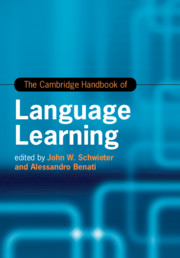Book contents
- The Cambridge Handbook of Language Learning
- Cambridge Handbooks in Language and Linguistics
- The Cambridge Handbook of Language Learning
- Copyright page
- Contents
- Figures
- Tables
- Contributors
- Acknowledgements
- Introduction
- Part I Theories
- 1 Formal Linguistic Approaches to Adult L2 Acquisition and Processing
- 2 Cognitive Approaches to Second Language Acquisition
- 3 The Qualitative Science of Vygotskian Sociocultural Psychology and L2 Development
- 4 Theoretical Frameworks in L2 Acquisition
- Part II Methods
- Part III Skill Development
- Part IV Individual Differences
- Part V Pedagogical Interventions and Approaches
- Part VI Context and Environment
- Part VII Moving Forward
- Index
- References
2 - Cognitive Approaches to Second Language Acquisition
from Part I - Theories
Published online by Cambridge University Press: 25 June 2019
- The Cambridge Handbook of Language Learning
- Cambridge Handbooks in Language and Linguistics
- The Cambridge Handbook of Language Learning
- Copyright page
- Contents
- Figures
- Tables
- Contributors
- Acknowledgements
- Introduction
- Part I Theories
- 1 Formal Linguistic Approaches to Adult L2 Acquisition and Processing
- 2 Cognitive Approaches to Second Language Acquisition
- 3 The Qualitative Science of Vygotskian Sociocultural Psychology and L2 Development
- 4 Theoretical Frameworks in L2 Acquisition
- Part II Methods
- Part III Skill Development
- Part IV Individual Differences
- Part V Pedagogical Interventions and Approaches
- Part VI Context and Environment
- Part VII Moving Forward
- Index
- References
Summary
In this chapter, we describe the constructs and working assumptions that characterize such approaches to language learning, with a particular focus on their cognitive underpinnings and how these explain differences between the linguistic forms that distinguish L1 and L2 speakers. We first define constructions as the targets of language learning and then describe the processes of construction learning in terms of exemplar-based, rational, associative learning. Not all constructions are equally learnable by all learners: naturalistic second language learners process open-class words more efficiently than grammatical cues even though the grammatical cues may be more frequent. We outline a usage-based account of this phenomenon in terms of salience, contingency, and redundancy, and explain how effects of learned attention and blocking further limit learning in adult L2 learners. We describe educational interventions taking these findings into consideration and conclude with further readings on usage-based approaches to L2 acquisition.
- Type
- Chapter
- Information
- The Cambridge Handbook of Language Learning , pp. 41 - 61Publisher: Cambridge University PressPrint publication year: 2019
References
- 16
- Cited by

